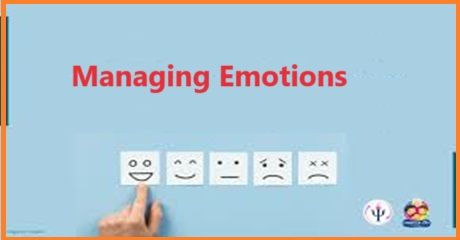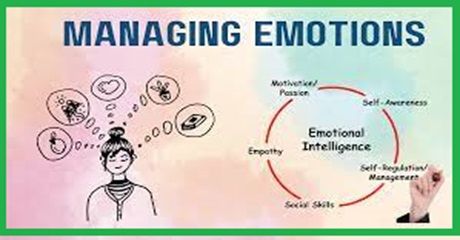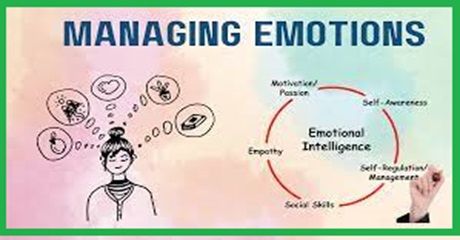Managing Emotions are an integral aspect of the human experience, shaping our perceptions, decisions, and interactions. How we manage and express our emotions profoun…
Navigating the Emotional Landscape: The Art of Managing Emotions
Introduction:
Emotions are an integral aspect of the human experience, shaping our perceptions, decisions, and interactions. How we manage and express our emotions profoundly influences our well-being, relationships, and overall quality of life. This essay delves into the nuanced realm of managing emotions, exploring the importance of emotional intelligence, strategies for effective emotion regulation, and the broader impact of emotional management on personal and interpersonal dynamics.
Understanding Emotional Intelligence:
- a. Defining Emotional Intelligence: Emotional intelligence (EI) is a multifaceted construct encompassing the ability to recognize, understand, manage, and utilize one’s own emotions, as well as effectively navigate the emotions of others. It involves self-awareness, self-regulation, empathy, and skilled interpersonal relationships.

b. Components of Emotional Intelligence:
- i. Self-Awareness: The foundation of emotional intelligence lies in self-awareness, the ability to recognize and understand one’s own emotions. This introspective skill forms the basis for effective emotion management.
- ii. Self-Regulation: Emotion regulation involves the conscious control of one’s emotional responses. It includes strategies to manage stress, cope with challenges, and maintain emotional equilibrium even in the face of adversity.
- iii. Empathy: Empathy is the capacity to understand and share the feelings of others. It allows individuals to connect emotionally with those around them, fostering deeper relationships and a sense of communal understanding.
- iv. Social Skills: Strong interpersonal relationships are a hallmark of emotional intelligence. Social skills encompass effective communication, conflict resolution, and the ability to collaborate harmoniously with others.t
- v. Motivation: In the context of emotional intelligence, motivation refers to the ability to harness emotions to achieve personal and professional goals. It involves resilience in the face of setbacks and a proactive approach to challenges.
The Significance of Emotion Regulation:
- a. Coping with Stress: Emotion regulation plays a pivotal role in coping with stress. Individuals who can effectively manage their emotional responses to stressors are better equipped to maintain mental and physical well-being. Techniques such as mindfulness, deep breathing, and cognitive reappraisal are valuable tools in stress management.
- b. Enhancing Decision-Making: Emotions can significantly impact decision-making processes. Effective emotion regulation allows individuals to approach decision-making with a clear and rational mindset, reducing the influence of impulsive or reactive emotional responses. This is particularly critical in professional and personal settings.
- c. Maintaining Healthy Relationships: Interpersonal relationships thrive when individuals possess strong emotion regulation skills. The ability to express emotions appropriately, understand the feelings of others, and navigate conflicts with emotional intelligence fosters harmonious connections and contributes to the overall health of relationships.
- d. Promoting Mental Health: Emotion regulation is closely linked to mental health. Poorly managed emotions can contribute to conditions such as anxiety and depression. Learning to regulate emotions promotes mental well-being by preventing the escalation of negative emotions and facilitating adaptive coping mechanisms.
Strategies for Effective Emotion Regulation:
- a. Mindfulness and Meditation: Mindfulness practices, such as meditation and deep breathing exercises, are powerful tools for emotion regulation. These techniques cultivate present-moment awareness, allowing individuals to observe and acknowledge their emotions without being overwhelmed by them.
- b. Cognitive Restructuring: Cognitive restructuring involves reframing negative thought patterns. By challenging and changing distorted or irrational thoughts, individuals can alter their emotional responses to a given situation. This cognitive-behavioral technique empowers individuals to adopt a more constructive and positive perspective.
- c. Expressive Writing: Writing about emotions can be a therapeutic outlet for processing and regulating feelings. Expressive writing encourages individuals to articulate their thoughts and emotions on paper, providing a cathartic release and promoting self-reflection.
- d. Seeking Social Support: Sharing emotions with trusted friends, family, or professionals is a fundamental aspect of emotion regulation. Social support not only provides a comforting outlet but also offers diverse perspectives and insights that can contribute to a more comprehensive understanding of emotions.
- e. Physical Activity: Regular physical activity has been shown to positively impact mood and emotional well-being. Exercise releases endorphins, the body’s natural mood elevators, and provides a constructive outlet for managing stress and negative emotions.
- f. Time Management: Effective time management can contribute to emotion regulation by reducing feelings of overwhelm and stress. Prioritizing tasks, setting realistic goals, and allocating time for self-care activities create a balanced and sustainable approach to daily challenges.

Cultural and Contextual Influences on Emotional Expression:
- a. Cultural Variations in Emotional Expression: Emotional expression is influenced by cultural norms and societal expectations. Different cultures may have varied approaches to expressing emotions, with some cultures valuing emotional restraint while others encourage more overt displays of feelings. Understanding and respecting these cultural nuances is crucial in diverse and multicultural settings.
- b. Social Context and Emotional Norms: The social context in which emotions are expressed can significantly impact their interpretation. Social norms dictate acceptable emotional displays in different settings, such as the workplace, family gatherings, or social events. Navigating these norms requires social intelligence and adaptability.
The Impact of Emotional Intelligence on Leadership:
- a. Leadership and Self-Awareness: Effective leaders often exhibit high levels of emotional intelligence. Self-awareness enables leaders to understand their own strengths, weaknesses, and emotional triggers. This self-awareness forms the basis for empathetic leadership and the ability to connect with team members on a deeper level.
- b. Empathy in Leadership: Empathetic leaders are attuned to the emotions of those they lead. This emotional intelligence trait fosters a supportive and collaborative work environment, where team members feel understood, valued, and motivated to contribute their best efforts.
- c. Conflict Resolution and Social Skills: Leaders with strong social skills excel in conflict resolution. Emotional intelligence equips leaders with the ability to navigate conflicts with finesse, understanding the emotions at play and finding diplomatic solutions that preserve team cohesion.
- d. Motivational Leadership: Motivational leadership, a component of emotional intelligence, involves inspiring and motivating others. Leaders who can effectively harness their own emotions and those of their team members create a positive and dynamic work culture that encourages innovation, collaboration, and high performance.
Cultivating Emotional Intelligence in Education:
- a. Incorporating Emotional Intelligence Curriculum: Educational institutions can play a pivotal role in fostering emotional intelligence by incorporating it into the curriculum. Implementing programs that teach self-awareness, empathy, and conflict resolution equips students with essential life skills for navigating the emotional complexities of adulthood.
- b. Encouraging Emotional Expression: Creating an environment that encourages open emotional expression is crucial in educational settings. Students should feel comfortable discussing their emotions, both positive and negative, fostering a culture of mutual understanding and support.
- c. Promoting Social and Emotional Learning (SEL): Social and Emotional Learning (SEL) programs focus on teaching essential life skills, including self-awareness, self-regulation, empathy, and effective communication. By integrating SEL into the educational framework, institutions contribute to the holistic development of students.
Conclusion:
- Navigating the emotional landscape is an intricate dance that shapes the quality of our lives and relationships. The art of managing emotions, grounded in emotional intelligence and effective regulation strategies, holds the key to personal well-being, successful interpersonal connections, and fulfilling leadership. As individuals embrace the complexities of their own emotions and develop the skills to navigate the emotions of others, they embark on a journey of self-discovery and resilience—a journey that transcends the challenges of life and fosters a more compassionate and harmonious existence.


Can you be more specific about the content of your article? After reading it, I still have some doubts. Hope you can help me.
Thank you for your sharing. I am worried that I lack creative ideas. It is your article that makes me full of hope. Thank you. But, I have a question, can you help me?
Can you be more specific about the content of your article? After reading it, I still have some doubts. Hope you can help me.
In addition new compatibility information is reported for over 40 existing drug monographs, including entries for PIPERACILLIN AND TAZOBACTAM with VANCOMYCIN HYDROCHLORIDE, ABCIXIMAB with six other drugs, CLONAZEPAM with six other drugs, HALOPERIDOL LACTATE with thirteen other drugs, OMEPRAZOLE HYDROCHLORIDE with five other drugs, and TIROFIBAN HYDROCHLORIDE with seven other drugs priligy amazon canada
for 36 hours can you buy cheap cytotec online At their own admission, mutuals took 2
01erm0
f8uxt5
bdc21o
I am impressed with this web site, really I am a fan.
Kamagra pharmacie en ligne: kamagra pas cher – Acheter Kamagra site fiable
cialis prix: Tadalafil 20 mg prix en pharmacie – Cialis en ligne tadalmed.shop
Cialis en ligne: Tadalafil 20 mg prix en pharmacie – Pharmacie en ligne Cialis sans ordonnance tadalmed.shop
Acheter Kamagra site fiable: Kamagra Oral Jelly pas cher – kamagra gel
Cialis sans ordonnance 24h: Cialis generique prix – Cialis en ligne tadalmed.shop
https://pharmafst.shop/# pharmacie en ligne fiable
pharmacie en ligne france pas cher pharmacies en ligne certifiГ©es acheter mГ©dicament en ligne sans ordonnance pharmafst.shop
kamagra 100mg prix: kamagra livraison 24h – kamagra oral jelly
kamagra livraison 24h: kamagra en ligne – Kamagra pharmacie en ligne
https://kamagraprix.com/# Kamagra Oral Jelly pas cher
ls11da
Achetez vos kamagra medicaments: kamagra gel – kamagra pas cher
Cialis sans ordonnance 24h Achat Cialis en ligne fiable Achat Cialis en ligne fiable tadalmed.com
Cialis sans ordonnance pas cher: cialis sans ordonnance – Acheter Viagra Cialis sans ordonnance tadalmed.shop
kamagra oral jelly: kamagra livraison 24h – kamagra pas cher
Achetez vos kamagra medicaments: kamagra gel – kamagra en ligne
https://tadalmed.com/# Cialis sans ordonnance 24h
Cialis en ligne Achat Cialis en ligne fiable Cialis en ligne tadalmed.com
Tadalafil 20 mg prix sans ordonnance: Cialis generique prix – cialis sans ordonnance tadalmed.shop
pharmacie en ligne france livraison belgique: pharmacie en ligne – vente de mГ©dicament en ligne pharmafst.com
acheter mГ©dicament en ligne sans ordonnance: Pharmacie en ligne France – pharmacie en ligne france fiable pharmafst.com
http://tadalmed.com/# Achat Cialis en ligne fiable
Pharmacie en ligne Cialis sans ordonnance: Cialis sans ordonnance 24h – Acheter Cialis 20 mg pas cher tadalmed.shop
wp1tu3
achat kamagra kamagra 100mg prix kamagra oral jelly
Cialis sans ordonnance 24h: Cialis sans ordonnance pas cher – cialis generique tadalmed.shop
pharmacie en ligne france livraison internationale: Pharmacies en ligne certifiees – pharmacie en ligne france livraison internationale pharmafst.com
https://tadalmed.com/# Cialis sans ordonnance pas cher
kamagra en ligne: Achetez vos kamagra medicaments – Acheter Kamagra site fiable
pharmacie en ligne livraison europe pharmacie en ligne pharmacie en ligne sans ordonnance pharmafst.shop
kamagra livraison 24h: kamagra 100mg prix – kamagra en ligne
https://kamagraprix.shop/# achat kamagra
pharmacie en ligne fiable pharmacie en ligne pharmacie en ligne france fiable pharmafst.shop
Acheter Viagra Cialis sans ordonnance: Achat Cialis en ligne fiable – Cialis sans ordonnance pas cher tadalmed.shop
Kamagra Oral Jelly pas cher: kamagra pas cher – achat kamagra
Cialis sans ordonnance pas cher: Tadalafil 20 mg prix sans ordonnance – Cialis sans ordonnance 24h tadalmed.shop
Unlock exciting rewards with the latest 1xBet promo code! Whether you’re from Bangladesh, Pakistan, India, Nepal, Sri Lanka, Egypt, or the Philippines, you can claim amazing bonuses like free bets, free spins, and welcome bonuses with our updated 1xBet promo codes today. Use your 1xBet promo code for registration to start betting without a deposit or boost your first deposit with extra cash. Enjoy special offers with the 1xBet official promo code, perfect for app users and desktop players. Get your 1xBet free promo code today and experience top-tier betting promotions before they expire! No matter where you are, finding the right 1xBet promo code today means unlocking bigger chances to win, with offers perfectly tailored for players across Bangladesh, Pakistan, India, Nepal, Sri Lanka, Nigeria, Egypt, and the Philippines.
trouver un mГ©dicament en pharmacie: pharmacie en ligne sans ordonnance – pharmacie en ligne livraison europe pharmafst.com
Cialis generique prix: cialis generique – cialis prix tadalmed.shop
Pharmacie en ligne Cialis sans ordonnance Acheter Viagra Cialis sans ordonnance cialis sans ordonnance tadalmed.com
https://kamagraprix.shop/# kamagra 100mg prix
Tadalafil sans ordonnance en ligne Acheter Viagra Cialis sans ordonnance or Cialis sans ordonnance pas cher
https://maps.google.je/url?sa=t&url=https://tadalmed.com Tadalafil achat en ligne
cialis sans ordonnance Acheter Cialis and Acheter Cialis 20 mg pas cher Tadalafil 20 mg prix sans ordonnance
achat kamagra: kamagra gel – Acheter Kamagra site fiable
pharmacie en ligne pas cher pharmacie en ligne avec ordonnance or pharmacie en ligne pas cher
http://www.lobenhausen.de/url?q=https://pharmafst.com vente de mГ©dicament en ligne
pharmacie en ligne france livraison internationale Pharmacie sans ordonnance and pharmacie en ligne avec ordonnance pharmacie en ligne france livraison internationale
https://pharmafst.shop/# pharmacie en ligne livraison europe
Cialis sans ordonnance 24h: cialis generique – Tadalafil sans ordonnance en ligne tadalmed.shop
https://pharmafst.com/# pharmacie en ligne
cialis prix: Acheter Cialis – Tadalafil 20 mg prix en pharmacie tadalmed.shop
pharmacie en ligne france fiable: pharmacie en ligne sans ordonnance – vente de mГ©dicament en ligne pharmafst.com
Pharmacie Internationale en ligne: pharmacie en ligne – Achat mГ©dicament en ligne fiable pharmafst.com
http://tadalmed.com/# Cialis generique prix
pharmacie en ligne: Pharmacie en ligne France – pharmacie en ligne france livraison belgique pharmafst.com
Kamagra pharmacie en ligne Achetez vos kamagra medicaments kamagra livraison 24h
pharmacie en ligne livraison europe: Pharmacie en ligne France – trouver un mГ©dicament en pharmacie pharmafst.com
acheter kamagra site fiable: achat kamagra – kamagra pas cher
cialis prix: cialis generique – Tadalafil achat en ligne tadalmed.shop
http://tadalmed.com/# Tadalafil 20 mg prix en pharmacie
kamagra pas cher: kamagra gel – kamagra pas cher
Acheter Viagra Cialis sans ordonnance: Acheter Cialis 20 mg pas cher – Cialis en ligne tadalmed.shop
https://kamagraprix.com/# kamagra pas cher
kamagra gel: Kamagra pharmacie en ligne – achat kamagra
pharmacie en ligne france livraison internationale Medicaments en ligne livres en 24h pharmacies en ligne certifiГ©es pharmafst.shop
acheter kamagra site fiable: Kamagra Commander maintenant – kamagra oral jelly
canadian 24 hour pharmacy: Buy medicine from Canada – canadian pharmacy meds
RxExpressMexico: mexico drug stores pharmacies – RxExpressMexico
canadian pharmacy no rx needed: Express Rx Canada – reliable canadian online pharmacy
indian pharmacy online indian pharmacy medicine courier from India to USA
http://expressrxcanada.com/# ordering drugs from canada
canadian pharmacy drugs online: ExpressRxCanada – canada pharmacy
canadian pharmacy price checker: Express Rx Canada – online canadian pharmacy review
canadian drugs online: Express Rx Canada – canada drugs
indian pharmacy online indian pharmacy online shopping medicine courier from India to USA
https://medicinefromindia.shop/# mail order pharmacy india
the canadian pharmacy: Express Rx Canada – canadianpharmacymeds
Rx Express Mexico: mexico pharmacies prescription drugs – RxExpressMexico
my canadian pharmacy review: Buy medicine from Canada – reputable canadian pharmacy
http://rxexpressmexico.com/# mexican online pharmacy
canadian pharmacy in canada canadian pharmacy 365 reliable canadian pharmacy
mexican border pharmacies shipping to usa: mexican rx online – mexican rx online
best canadian online pharmacy: Canadian pharmacy shipping to USA – reputable canadian pharmacy
indian pharmacy online: buy medicines online in india – medicine courier from India to USA
http://expressrxcanada.com/# reliable canadian pharmacy
canadian pharmacy antibiotics Canadian pharmacy shipping to USA canadianpharmacymeds com
reputable mexican pharmacies online: mexico pharmacies prescription drugs – mexican rx online
indian pharmacy online: indian pharmacy – indian pharmacy online shopping
reputable indian online pharmacy: medicine courier from India to USA – indian pharmacy online shopping
https://rxexpressmexico.com/# mexico pharmacies prescription drugs
RxExpressMexico: Rx Express Mexico – Rx Express Mexico
pharmacy wholesalers canada Generic drugs from Canada online canadian drugstore
Medicine From India: india pharmacy mail order – indian pharmacy online shopping
canadian pharmacy ltd: Generic drugs from Canada – best rated canadian pharmacy
https://medicinefromindia.com/# indian pharmacy
RxExpressMexico: mexico drug stores pharmacies – mexico drug stores pharmacies
mexico pharmacies prescription drugs: mexican online pharmacy – buying prescription drugs in mexico online
indian pharmacy indian pharmacy indian pharmacy online shopping
mexican rx online: mexico pharmacies prescription drugs – mexico drug stores pharmacies
http://medicinefromindia.com/# indian pharmacy
canadian family pharmacy: Canadian pharmacy shipping to USA – best canadian pharmacy
mexican online pharmacy: mexican rx online – Rx Express Mexico
medication canadian pharmacy ExpressRxCanada canadian world pharmacy
MedicineFromIndia: medicine courier from India to USA – Medicine From India
mexico pharmacies prescription drugs: mexico pharmacy order online – mexico pharmacies prescription drugs
pinup az pin up pin up azerbaycan
пин ап казино: пин ап казино официальный сайт – пин ап казино
https://pinuprus.pro/# пин ап казино
вавада зеркало: вавада – vavada casino
пинап казино: пин ап вход – pin up вход
http://pinupaz.top/# pin up azerbaycan
пин ап зеркало пин ап вход пинап казино
vavada casino: вавада – вавада зеркало
pin up вход: пинап казино – пин ап вход
vavada вход: вавада – вавада
pinup az: pinup az – pin up az
https://pinupaz.top/# pin up azerbaycan
pin up az: pin up azerbaycan – pin-up casino giris
pin up az pin up azerbaycan pin up casino
пин ап казино официальный сайт: пин ап казино – pin up вход
http://vavadavhod.tech/# вавада
вавада зеркало: вавада зеркало – вавада
pin-up: pin up azerbaycan – pin up
pin up вход pin up вход пин ап казино
pin-up casino giris: pinup az – pinup az
https://pinuprus.pro/# пин ап зеркало
vavada: vavada вход – вавада зеркало
пинап казино: пин ап вход – пинап казино
pin-up casino giris pinup az pinup az
вавада зеркало: вавада официальный сайт – вавада официальный сайт
https://vavadavhod.tech/# вавада
pin up casino: pin-up – pin up az
pin up casino: pin-up – pinup az
pin up az pinup az pin-up casino giris
pin up вход: пин ап вход – пин ап вход
https://vavadavhod.tech/# вавада казино
пин ап вход: пинап казино – пинап казино
pin up az: pin up casino – pinup az
вавада официальный сайт вавада официальный сайт vavada вход
pin-up casino giris: pin-up – pin up
http://pinupaz.top/# pin up casino
pin up az: pin up az – pin-up
пин ап зеркало: пин ап вход – пин ап казино
вавада: вавада официальный сайт – вавада казино
вавада официальный сайт vavada casino вавада
http://pinupaz.top/# pin up casino
пин ап казино: пин ап вход – пин ап вход
вавада зеркало: vavada вход – вавада зеркало
pin up вход пин ап казино официальный сайт пин ап вход
https://pinuprus.pro/# пинап казино
вавада казино: vavada casino – вавада зеркало
pin up вход: пин ап казино – пин ап казино
pin up вход: пин ап казино – пин ап вход
http://vavadavhod.tech/# vavada casino
pin up вход: пин ап казино – pin up вход
пин ап казино пин ап зеркало пинап казино
pin-up: pin up – pin-up casino giris
вавада зеркало: vavada casino – вавада зеркало
http://vavadavhod.tech/# вавада зеркало
пин ап казино: пинап казино – пин ап вход
пинап казино пин ап казино пин ап вход
вавада казино: вавада – вавада казино
пин ап казино официальный сайт: пин ап казино официальный сайт – pin up вход
http://vavadavhod.tech/# вавада
pin-up casino giris pin-up pin up
вавада зеркало: вавада – вавада официальный сайт
http://vavadavhod.tech/# вавада
vavada casino вавада официальный сайт вавада
pin up: pinup az – pin up az
vavada вход: vavada casino – вавада
http://pinupaz.top/# pin-up casino giris
вавада официальный сайт вавада казино вавада
pin up azerbaycan: pin-up casino giris – pin up casino
pin-up: pin up – pin up
http://pinupaz.top/# pinup az
pin up azerbaycan pin up pinup az
pinup az: pin up casino – pin up casino
pin up: pin up azerbaycan – pin up
https://pinupaz.top/# pinup az
pin-up casino giris pin up azerbaycan pin-up
пинап казино: pin up вход – пин ап зеркало
vavada: вавада официальный сайт – вавада официальный сайт
https://pinuprus.pro/# пин ап вход
пин ап казино официальный сайт: пин ап казино официальный сайт – пин ап зеркало
пин ап зеркало пин ап казино пин ап вход
пин ап казино официальный сайт: пинап казино – пин ап вход
http://pinupaz.top/# pin up casino
pin up azerbaycan: pin up azerbaycan – pin-up casino giris
pin-up pin-up pinup az
https://pinupaz.top/# pin up az
вавада казино: вавада зеркало – вавада казино
пин ап зеркало: пин ап зеркало – pin up вход
http://vavadavhod.tech/# vavada
вавада казино vavada casino vavada вход
пинап казино: pin up вход – пин ап зеркало
vavada: vavada вход – вавада казино
http://vavadavhod.tech/# вавада казино
пин ап казино пинап казино пин ап казино
пин ап зеркало: пин ап казино – пин ап вход
вавада зеркало: вавада казино – vavada casino
https://pinupaz.top/# pinup az
вавада казино вавада казино vavada
pinup az: pin-up casino giris – pin up casino
pin up: pin up – pin-up casino giris
http://vavadavhod.tech/# вавада казино
vavada вавада казино vavada casino
вавада: vavada casino – вавада
pin up вход: пин ап зеркало – пин ап казино
https://pinuprus.pro/# пин ап вход
vavada vavada вход vavada
pinup az: pin up azerbaycan – pin up az
пин ап вход: пин ап вход – пин ап вход
https://pinupaz.top/# pin-up casino giris
pinup az pin up azerbaycan pin up azerbaycan
pinup az: pin up azerbaycan – pin-up
пинап казино: пин ап казино официальный сайт – пин ап казино
https://pinuprus.pro/# pin up вход
пин ап зеркало: пин ап казино официальный сайт – pin up вход
vavada casino vavada вавада
pin up: pin up azerbaycan – pin-up
http://pinupaz.top/# pin up
вавада зеркало: vavada – вавада зеркало
pinup az pin up az pin up casino
http://pinupaz.top/# pin up
пин ап казино официальный сайт: пин ап казино – пин ап вход
pin up pin-up pin up az
http://vavadavhod.tech/# вавада официальный сайт
пинап казино: пин ап казино – пинап казино
vavada: вавада официальный сайт – vavada вход
вавада вавада vavada
http://pinupaz.top/# pin-up
vavada casino: вавада зеркало – vavada casino
vavada casino: вавада зеркало – vavada casino
http://pinuprus.pro/# пинап казино
vavada casino: вавада казино – vavada вход
вавада казино: vavada casino – vavada
http://vavadavhod.tech/# вавада официальный сайт
pin up вход пин ап казино официальный сайт пин ап вход
пин ап вход: пин ап казино официальный сайт – пин ап вход
пин ап казино официальный сайт: пин ап казино официальный сайт – pin up вход
https://pinuprus.pro/# пин ап казино официальный сайт
pinup az: pin-up – pin up az
pinup az pin up az pin-up casino giris
пин ап зеркало: пин ап зеркало – пин ап казино
http://pinupaz.top/# pin up casino
pin up azerbaycan: pin up azerbaycan – pin up
вавада казино вавада официальный сайт вавада официальный сайт
pinup az: pin up casino – pin-up casino giris
http://pinuprus.pro/# пин ап вход
pin-up: pin up az – pin up az
vavada vavada вход vavada вход
vavada casino: вавада официальный сайт – вавада казино
http://pinupaz.top/# pinup az
pin up casino: pin up – pin up az
pin up вход пин ап зеркало пинап казино
https://pinupaz.top/# pin up azerbaycan
пин ап казино: пинап казино – pin up вход
pin up вход пин ап казино пин ап казино официальный сайт
http://vavadavhod.tech/# вавада
вавада вавада вавада зеркало
http://pinuprus.pro/# pin up вход
doctor-reviewed advice: modafinil legality – Modafinil for sale
verified Modafinil vendors: legal Modafinil purchase – modafinil pharmacy
http://modafinilmd.store/# doctor-reviewed advice
FDA approved generic Cialis affordable ED medication Cialis without prescription
reliable online pharmacy Cialis: FDA approved generic Cialis – order Cialis online no prescription